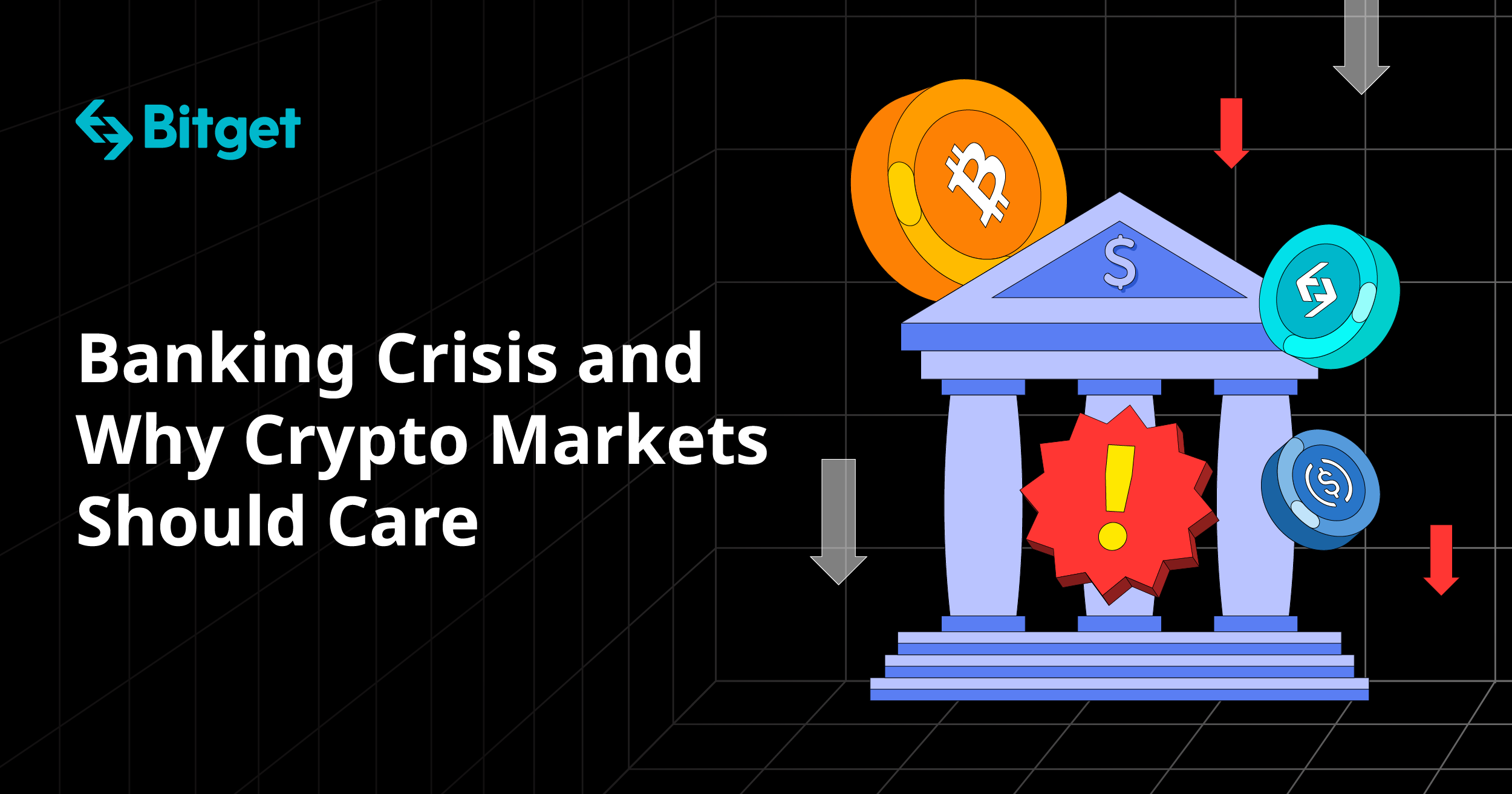
Banking Crisis and Why Crypto Markets Should Care (Part 1)
It's a dark month for the banking industry as U.S.-based Silvergate, Silicon Valley Bank, Signature Bank, and even Swiss giant Credit Suisse have closed their doors for good. Two of them were crypto-friendly banks, another served as a go-to for many of the crypto's startups and venture capital firms, and the last is a legendary bank for high-stakes missions. Is the banking crisis the crypto fault? And what does this mean for the market as a whole?
Counting down to collapse: A summary
Silvergate Bank was originally a California-based community bank that commenced operations in the late 1990s. Since at least 2013, Silvergate Bank has been involved in the cryptocurrency industry by providing Bitcoin exchanges with banking services. Silvergate launched the Silvergate Exchange Network (SEN) in 2018 in an effort to innovate and provide customers with additional value. This cutting-edge system enables round-the-clock transfers between Silvergate accounts and provides access to US dollar loans secured with bitcoin. The formal SEN’s partner list includes Coinbase, Circle, Paxos, Galaxy Digital, LedgerX, and Bitstamp, among others.
Silicon Valley Bank (SVB) was founded in 1983 as a commercial bank in the center of Silicon Valley, California, which is home to many of the world's leading technology companies, such as Apple, Intel, and Nvidia. SVB is a leading financial institution that provides specialized banking services, including venture debt, asset-based lending, growth capital, and cash management, to innovative and fast-growing technology companies, venture capitalists, and private equity investors. Its operations go beyond the United States, with offices in Europe, Asia, and Israel, demonstrating its global reach.
Signature Bank is a commercial bank headquartered in New York with branches throughout the metropolitan area and a national online platform. It is one of the largest crypto lenders with its own blockchain-based platform called Signet, which enables instant and secure digital token transactions between its clients. The bank's total assets surpassed US$87 billion in 2021, and it was proudly listed on the NASDAQ under the symbol SBNY.
Credit Suisse, headquartered in Zurich, Switzerland, is a leading global provider of financial services. Since its founding in 1856, the bank has served clients in a variety of industries and geographic locations. It has been involved in various ways with blockchain and digital assets. Credit Suisse participated in a consortium of banks in 2018 that successfully tested blockchain technology for syndicated loans. In 2022, Credit Suisse's total asset portfolio was worth 531.4 billion Swiss francs, and its global workforce exceeded 50,000.
A timeline of the crisis
In the midst of economic upheaval, the once-mighty titans of finance have tumbled like a house of cards, leaving chaos in their wake. As the Federal Reserve began raising rates in 2022, there was a noticeable reduction in venture capital availability. This resulted in startups experiencing a cash burn, which put pressure on financial institutions such as Silicon Valley Bank. As a consequence, the bank had to liquidate some of its government bonds at significant losses as yields on new bonds were markedly higher.
It is the beginning of the end. In a matter of weeks, the world watched in horror as bank after bank collapsed, their once-gleaming headquarters reduced to rubble. First came Silvergate, then Silicon Valley Bank, Signature Bank, and even the mighty Credit Suisse, which had weathered countless storms in its long and storied history.

Banking disaster: Major economic factors behind the collapse
Silicon Valley Bank's recent collapse is no small matter, despite its relatively modest status as the 16th largest bank in the US, valued at under US$1 billion and possessing less than 1% of the total assets held by the country's banking system. While some may not consider banks of SVB's size to be worth much attention, the truth is that its failure could trigger a domino effect that reverberates throughout the small and medium-sized commercial banking sector in the US, and this is what has people in the financial world on edge.
The banking system plays a significant role in channelizing funds between lenders and borrowers. Time deposits with the commercial bank are treated as a liability of the bank and have to be provided to the depositors upon calling[1]. However, in times of bank crisis, many banks fail to meet their obligations leading to a situation known as bank failure. For a commercial bank, the interest spread between lending and borrowing is the only source of profit. Therefore, historically the interest rate remained one of the major determinants of bank failure.
The expansionary monetary policy through four consecutive rounds of quantitative easing has caused a rightward shift in the aggregate demand leading to an inflationary period, and the recent interest rate hike is nothing but Fed’s attempts to bring down the mounting inflation rate[2]. The relationship between interest rate and the bond price is negative, implying that a higher interest rate will put downward pressure on bond prices. Recent FED hawkish actions are expected to come with “some pains” and “hardship” as per FED Chair Jerome Powell, but most of us didn’t even contemplate pricing in a systemic banking crisis.
Quantitative Easing
The primary responsibility of the Fed is to maintain price stability and promote economic growth[3]. Policy actions executed by the Fed can directly affect the operations of a commercial bank. In this regard, quantitative easing, frequently employed by the Fed as a monetary policy action, is one channel through which the Fed can change commercial banks' behavior[4]. The prime motive behind quantitative easing is to shift the aggregate demand outward by injecting money supply into the economy and lowering the interest rate. For instance, encountering the financial crisis of 2007-2008, the Fed introduced two rounds of quantitative easing via purchasing government bonds and enhancing banking lending capacity. When aggregate demand shifts to the right, the inflation rate also increases [5]. But the first two rounds of quantitative easing did not cause inflation.

Quantitative easing, on the one hand, increased the attractiveness of holding long-term treasury bonds for banks, but on the other hand, its post-Covid execution has caused inflation to rise.
Inflation Rate
However, the fourth round of quantitative easing due to the pandemic has increased the inflation rate in the United States. For instance, Figure 1 shows that since the fourth round of QE, the inflation rate is 16% higher in March 2023. Theoretically, successive injecting money supply and holding the interest rate near to lower bound are the same as inviting hyperinflation rate.

Figure 1: Consumer Price Index for All Urban Consumers: All Items in the U.S. City Average
The Consumer Price Index (CPI) for All Urban Consumers, which measures the average change in prices of goods and services purchased by households, has increased steadily from January 2020 to January 2023. The CPI was at 259.037 in January 2020 and reached 300.536 in January 2023, indicating an overall increase of 16.1% over the period. The CPI experienced a slight decrease in 2020 due to the COVID-19 pandemic, but it began to rise again in mid-2020 and has continued to increase since then. This rise in CPI suggests that the cost of living has increased over the past few years; in other words, there was inflation in the US economy.
Interest Rate Hike
Theoretically, inflationary situations demand interest rate hike; therefore, the Fed has constantly raised the interest rate throughout the FY 2022-2023. For instance, considering the negative relationship between interest rate and investment, the Fed has raised the interest rate from near zero to 5%, a total of 450 basis points[6]. As we mentioned earlier that commercial banks make a profit from the interest spread between lending and borrowing; a higher interest rate would undermine commercial banks' profitability. With a higher interest rate, bond prices fall, and the downward pressure on the bond prices is severe for long-term Treasury bonds, which are considered a staple of investments under normal QE circumstances.

Composition of Bank’s Assets
The interest rate hike is disastrous for the smooth functioning of commercial banks[7]. Due to the lower interest rate during the fourth round of quantitative easing, commercial banks have heavily invested in long-term treasury bonds. Typically, commercial banks do not hold long-term treasury bonds, but the successive rounds of quantitative easing increased the attractiveness of long-term treasury bonds. For instance, it is reported that 80% of the Silvergate Bank is constituted by long-term Treasury bonds[8]. This shows how the policy action of the Fed paves the way for bank collapse.

For instance, the Silvergate Bank has increased its purchase of Federal agency securities from 0 to 1,179 million while responding to lower bound interest rates during the 4th round of quantitative easing. In the same way, SVB has increased from 640 million to 805, and Signature Bank has increased from 50 million to 1,988 million. The SVB increased its Purchases of State Municipal securities almost by 50% in 2021, and the same is true for Silvergate Bank. However, the interest rate hike has decreased the price of these securities to an unprecedented level and placed pressure on corporate customers. As a result, rocketing liquidity demand for customer deposits and the default risk of outstanding loans put pressure on these banks to sell the above-mentioned securities at lower prices and paved the way for bank failure.
Opportunities For Crypto Markets
As traditional banks continue to fail, the cryptocurrency market becomes a beacon of stability and security for those seeking a way to protect their assets from the volatile financial landscape. The value of cryptocurrencies skyrockets, with new investors flocking to invest in this promising digital asset.
Bitcoin's phoenix-like rise
The aftermath of the scandals at Silvergate, Silicon Valley Bank, Signature Bank, and Credit Suisse are sending shockwaves through the markets, causing a precipitous decline in global bank stocks. Simultaneously, the cryptocurrency market, including bitcoin, is experiencing a remarkable upswing with double-digit gains.
The shutdown of Silicon Valley Bank on March 10 caused an 8% decline in the value of Bitcoin, causing it to fall below US$20,000 for the first time in nearly two months. Subsequently, following the FDIC's announcement of Silicon Valley Bank's receivership later that day, Bitcoin's value decreased by nearly US$300, falling below the US$20,000 threshold. Despite fluctuations, Bitcoin's value remained above US$20,000 for the majority of the weekend. Bitcoin reached an all-time high of US$24,164 on March 13, followed by a sharp increase to nearly US$26,000 in less than 24 hours. As of March 19, Bitcoin is trading for approximately US$28,031.
Consider investing in Bitcoin (BTC)? It only takes 2 minutes to create an account on Bitget and start trading Bitcoin!

The surging prices of Bitcoin have been a topic of much discussion and analysis in recent times. The current trend can be attributed to several factors, but one crucial aspect that stands out is the impact of interest rates on the cryptocurrency market. This relationship between interest rates and Bitcoin prices is not new and has been observed in the past. However, the recent surge in Bitcoin prices has been exceptional, making it essential to examine this relationship more closely.
Cryptocurrencies are considered risky assets that are highly sensitive to changes in the future direction of interest rates, just like many growth stocks. When interest rates rise, traders tend to move away from risky assets and into safer ones, and vice versa. In this context, the recent trend in Bitcoin prices can be understood as a response to the expectations surrounding the Federal Reserve's policy on interest rates.
The Federal Reserve has been pursuing a policy of rapidly raising short-term interest rates to control inflation, which has been at multi-decade highs recently. This has had several consequences, such as increasing the funding costs of banks, hurting bond prices, and capping stock prices. The impact of these actions has spilled over into the cryptocurrency market, as traders react to changes in the overall economic environment.
Crypto proponents see Bitcoin's recen t price movements as a sign of its stability and growing acceptance in mainstream financial circles. Bitcoin's perceived immunity to inflation and its decentralized nature has made it an attractive investment option for those seeking an alternative to traditional financial instruments.
CEXs should take the role of banking service providers
CEXs are essentially performing some of the duties once performed by banks. They act as a depository for their customers' assets, a conduit for monetary transactions, and a source of credit. Some exchanges have taken major steps toward becoming full-fledged financial institutions by introducing features like debit cards and fiat on-ramps.
Perhaps you're wondering why CEXs should play this part and what advantages it would offer.
CEXs offer several advantages over more convenient banking options. They are cheaper, more convenient, and faster than the alternatives. CEXs never sleep and are always open for trading, allowing users to conduct transactions whenever they desire and even facilitate international trade without the need for intermediaries. Moreover, their fees are typically lower than those of banks, making them an attractive option for customers who wish to reduce their transaction expenses.
CEXs also benefit from their established position within the cryptocurrency ecosystem. This means they can cater to the specific requirements of crypto users because they have a greater understanding of their desires and requirements. Banks can use these companies' blockchain expertise to develop innovative new products and services.
CEXs could help bridge the gap between traditional banking and cryptocurrencies by providing banking services. People who are unfamiliar with cryptocurrency and intimidated by the plethora of wallets, keys, and decentralized financial systems may find them useful. In addition, they may provide an approach for organizations to take advantage of blockchain technology without having to develop their own system from the ground up.
There are, of course, risks and difficulties associated with CEXs providing banking services. They would have to deal with intricate regulatory frameworks while also keeping their platforms secure and reliable.
As a leading centralized exchange with global compliance, including the U.S. and Canada's licenses, Bitget puts users' safety and protection first. To ensure our users' assets are safeguarded during major setbacks, Bitget has launched the Bitget Protection Fund, which is currently fixed at US$300 million, with 6500 BTC and 200 million USDT stored in seven publicly disclosed wallet addresses for users to monitor the fund in real-time. But our efforts don't end there! We have also introduced the Proof of Reserves Page (PoR), which demonstrates our status as a full-reserve exchange that uses the cryptographically-verified Merkle tree method. The PoR guarantees that users' assets stored on our platform are protected and that the data presented is genuine and consistent. For the most up-to-date information on the Proof of Reserves, please refer to this page.
Become a Bitgetter today, and let us accompany your investment journey!
Disclaimer: Whilst we strive to ensure that the information provided herein is obtained from reliable sources, we present it on an "as-is" basis without any representations as to its validity, accuracy, usefulness, timeliness, or completeness. We do not accept any responsibility for errors or omissions, losses, and/or damages arising from the display or use of this information.
The information, views, and opinions expressed in this report are those of Bitget at the time of publication and are subject to change due to economic or financial circumstances. We do not guarantee that this report will be updated or revised to reflect any changes that may arise after the date of publication.
This report is intended for informational and educational purposes only and should not be construed as legal, tax, investment, financial, or other advice. Bitget, our employees, agents, partners, and/or co-operations will not be held responsible for any decision made, action taken, or result obtained from or in reliance on the use of the information provided in this report. It is imperative that any investment or trading ideas, strategies, or actions are never taken without first taking into consideration each individual's personal and financial situation and/or without consulting financial professionals.
References
[1] Shaffer, S. (2012). Bank failure risk: Different now?
[2] Brei, M., Borio, C., Gambacorta, L. (2020). Bank intermediation activity in a low‐interest‐rate environment.
[3] First Republic, SVB, Credit Suisse crisis signals growing recession odds by Bloomberg.
[4] Quantitative easing explained by Forbes.
[5] Rosengren, E. S. (2015). Lessons from the US Experience with QE.
[6] Everything you need to get caught up on the SVB crisis by TechCrunch.
[7] A tale of 2 banks: Why Silvergate and Silicon Valley Bank collapsed by CoinDesk.
[8] Silvergate's bad debts weren't its assets but its deposits by The Washington Post.

- Gomble (GM): Bridging Casual Gaming and Blockchain2025-04-16 | 5m
- Wayfinder (PROMPT): The AI Compass for Blockchain Worlds2025-04-11 | 5m


